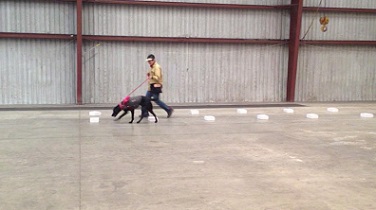It’s 2012, and we’ve been enjoying Nose Work for a whole year now. Tigger and I both love it. He is good at it, and it’s good for him. Nose Work class brings out the best in Tigger. He has charmed the people in our class by being funny, affectionate, and uncharacteristically sane. It feels great when people are proud of Tigger, instead of judging me for his outbursts.
Some classmates enter Nose Work competitions. They encourage me to compete with Tigger. I truly appreciate their support. But I wonder, will Tigger be ever able to compete? He’s great at searching. But can he handle getting there, being there, and the drive home? So many seemingly simple behaviors are beyond him. I have serious doubts.
There’s an ORT coming up in May 2012, in Santa Rosa, about 90 miles from home. To qualify for an NACSW Nose Work Trial, a dog is first required to pass an Odor Recognition Test, or ORT. I research what skills Tigger will need to succeed. I read the NACSW Trial rule book. I volunteer at a local Trial. I keep my eyes open. I ask questions. To my surprise, I conclude: “If we work on it, we might actually be able to do this!”
I make a list of the required behaviors he’s missing. I realize that every one of these items is a key life skill. Improvement will make his entire life easier, and ours. But it will be challenging. He is hyper-vigilant, always worried and never relaxed. He has no idea how to be calm, or even how it feels to be calm. His stress hormones seem to be in permanent overdrive. He is frequently in panic fight/flight mode, which makes thinking difficult, and wise decisions almost impossible. The upcoming ORT gives me focus, priorities, and a deadline, for the hard work ahead.
Taking in a brand new experience
Like most anxious dogs, Tigger craves routine. A regular schedule helps him feel more settled, in his unsettling world. Knowing what to expect reduces stress, and helps him feel just a bit more in control of his own life. We keep a very regular schedule, to bring a little order to Tigger’s life. But any break in the routine upsets him. He has temper tantrums when things don’t go as expected. Friends tell me that some autistic children struggle with this as well.
Riding in the car calmly
If you haven’t heard the ear-splitting scream of an extremely high prey drive dog, you have no idea just how loud and wild it sounds. This scream is not a voluntary behavior. It is an uncontrollable reflex, brought on by over-stimulation of the hunt instinct. Tigger also screams in impatience when nearing favorite locations. And once he gets started, he can’t stop; he doesn’t know how to calm himself. This won’t be solved by simply giving him cues and expecting him to follow through. He can’t even hear the cues through the chaos in his brain.
In addition, he barks wildly at anything that moves. A partial list includes dogs, cats, birds, joggers, bicycles, skate boards, scooters, motorcycles, plastic bags, and more.
Resting in the parked car
Tigger is hyper-vigilant in a parked car. He worries about every little noise, and anything that moves. In addition to the triggers listed above, he barks loudly at strangers who walk too close to his car. And goes berserk at nearby dogs. Even if I stay in the car with him, he can’t keep himself calm or quiet.
Patiently waiting his turn
High prey drive is correlated with low impulse control. Low impulse control is correlated with a lack of patience.
Successful hunting requires a hair-trigger response, because pausing even briefly to consider “should I give chase?” will mean losing the prey. Tigger’s prey drive is off the charts. His impulse control and patience are nonexistent. He does not know how to wait for anything, and cannot deal with frustration.
Walking from car to search area
Tigger is dog-reactive. That means he barks and lunges at dogs that he sees when he’s walked on a leash. NACSW Trial rules specify that all dogs must be on 6 foot leashes, and are to be kept several feet away from each other. When dogs aren’t going to or from searching, they are to be securely enclosed in a crate or car. Even so, this will be a big challenge.
Greeting people without jumping on them
Tigger likes people. He knows how to be polite — when he can control himself. But his excitement level can skyrocket at the slightest bit of stimulation, like getting to meet a new person or greet an old friend. Very few people appreciate a large friendly Labrador landing on the chest with tongue reaching for the face. We’ve made some progress, but have more work to do.
Tigger’s Birch ORT
Tigger and I work on these skills. Constantly. It’s exhausting. But he does improve — at least enough to attempt the ORT.
At the ORT, I worry. I stress. I spend an hour giving Tigger TTouch in the car to help him say calm. My husband Dave runs interference to shield us from other dogs. We get through the day. And with tail wagging happily, he passes his Birch ORT!
I am pleased he found his odor. Lots of dogs found odor that day.
It is a huge effort to prepare a dog “with issues” to be successful in competition. I am ecstatic, and bursting with pride, that he got through all challenges of the day.
Video and moral support provided by our Nose Work instructor, Pam Behrens of A Dog’s Day.
Solutions
What are your challenges? What did you do to address them? Are you still looking for solutions? Would you like to know Tigger’s training plans: what we tried, what worked, and what didn’t work? Let us know!
Copyright by Linda Fletcher, 2016

